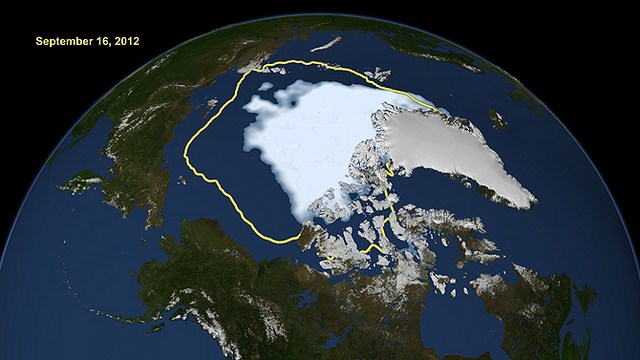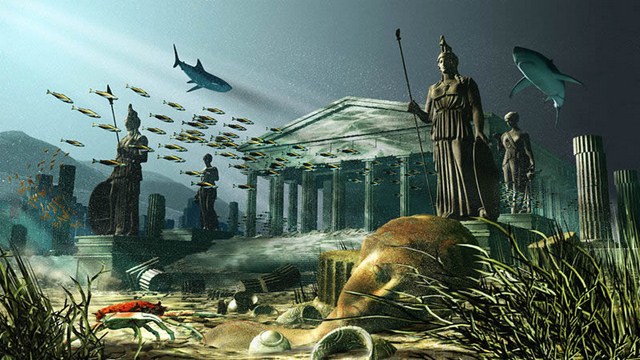
The frozen cap of the Arctic Ocean appears to have reached its lowest melting point of the year — and it breaks an all-time record low, according to NASA. The above graphic shows the ice cap at its lowest point of the season compared with its lowest point 30 years ago (in yellow). Here’s what you need to know.
1. Arctic Sea Ice Cover Melted to a New Record This Year

Sept. 16 marked the annual summertime minimum extent (in other words, maximum melting point) and broke a new record since 2007. The Arctic ice melted to 1.32 million square miles (24 percent of the Arctic Ocean’s surface) from 2007’s record low of 1.61 million square miles (29 percent).
2. The Record Smashes a Record that Smashed a Record
2007’s record low of 1.61 million square miles broke the record low in 2005 of 2.05 million square miles.
3. The Difference in Records is Larger than Texas

The new record measures almost 300,000 square miles less than 2007’s record. To put that in perspective, the state of Texas measures around 268,600 square miles.
4. There’s Still Time For More Melting
Although Sept. 16 marks the annual minimum, there’s still time for winds to change and compact the ice floes, potentially reducing the ice further. So basically, this is not the last we will be hearing about the issue.
5. A Powerful Cyclone Contributed to the Melting Record

This year, a cyclone ripped through the coast of Alaska and headed towards the center of the Arctic Ocean, weakening the ice and cutting off a large section. The chunk was pushed to warmer water where it eventually melted entirely. Claire Parkinson, a climate scientist at NASA explains how the storm affected the ice:
“The storm definitely seems to have played a role in this year’s unusually large retreat of the ice”, Parkinson said. “But that exact same storm, had it occurred decades ago when the ice was thicker and more extensive, likely wouldn’t have had as prominent an impact, because the ice wasn’t as vulnerable then as it is now.”
6. This Year is the First Time Arctic Ice has Dipped Below 4 Million Square Kilometers
7. Arctic Ice Freezes at the Beginning of Winter and Melts at the Start of Spring
The Arctic ice grows naturally during the dark winter season and begins to melt at the start of spring. The above video provides a visual of what a single cycle looks like.
8. The Arctic is Earth’s Air-Conditioner
The ice caps help keep the earth cool by reflecting 60 to 90 percent of the sun’s energy back into space, acting as Earth’s natural air-conditioner. When your air-conditioner at home breaks, you can call a repairman and it’s all fixed, right? But what happens when Earth’s natural air-conditioner breaks? We’re screwed.
9. The Decline of Arctic Sea Ice Does Not Mean a Rise in the World’s Oceans

Have you ever heard that since the ice caps are melting the oceans are going to rise? This is actually a misconception. The decline of Arctic sea ice does not mean rising oceans because the ice is already floating and displacing its weight in the water.
10. Some Scientists Think the Arctic Might be Free of Summer Ice by 2020
Yeah, that’s the word on the street. The government doesn’t seem to be worried, though. It may not scare the government, but it sure scares the s*** out of me! Does that mean in ten years winter as we know it will no longer exist and palm trees will be able to grow in Alaska? Oh boy.